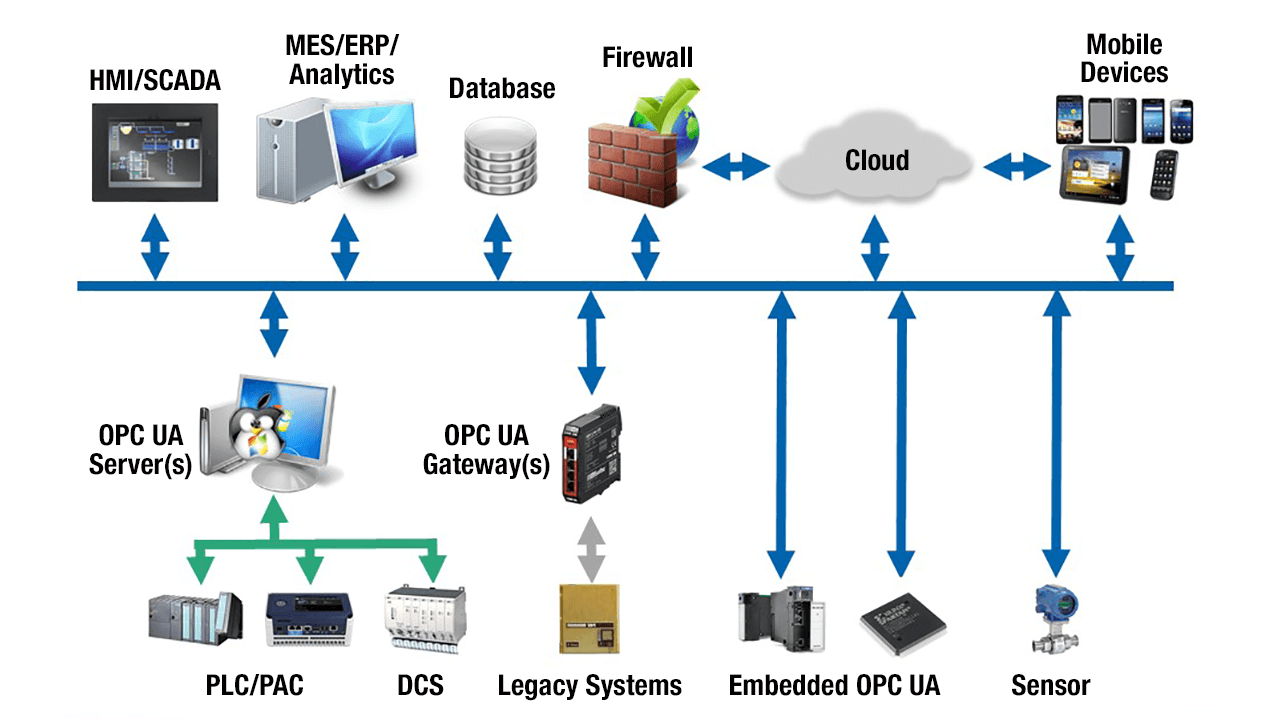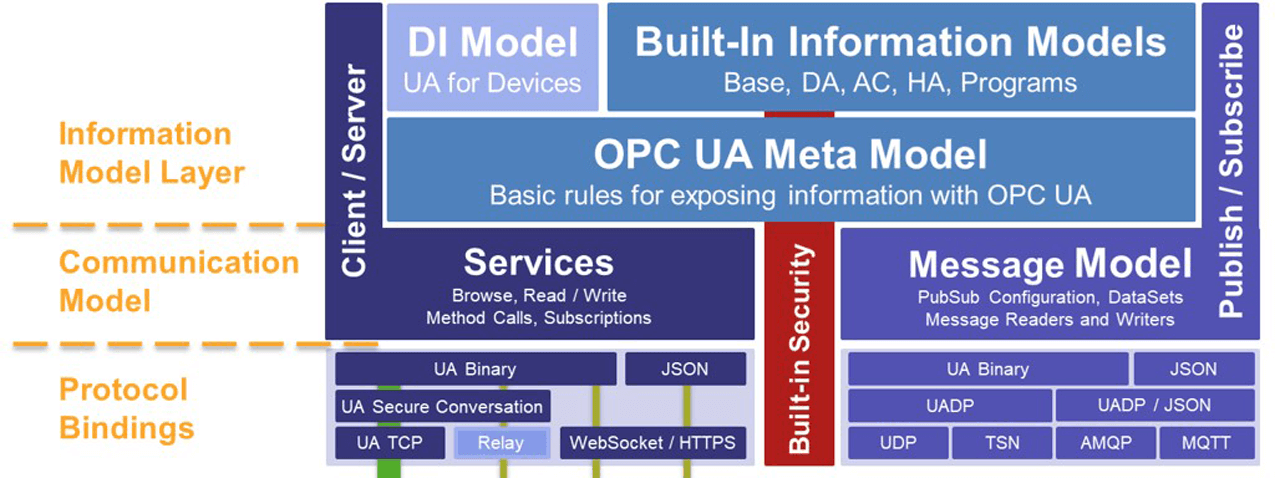TechnologyMay 27, 2019
PackML with OPC UA solution for machine integration

The combination of PackML and OPC UA can be used to solve strategic and machine integration issues facing manufacturers. PackML offers a standard for modeling industrial machine systems, and provides an effective architecture that can be used to control and monitor any sort of machinery, not just packaging machines.
The 2019 American Baseball Season is still new, and it’s interesting to compare how baseball managers and managers of manufacturing plants make decisions. Both face strategic and complex choices. While some baseball teams have turned to data, other teams have managers that rely on instinct, analyzing every pitch, hit and out.
Smart manufacturing challenges
Managing a manufacturing plant used to be pretty simple without much in the way of data or strategy. But now manufacturers are faced with unprecedented strategic challenges in this cloud-enabled, Big Data, Artificial Intelligence world. Staffing the factory floor, reducing costs, increasing efficiency and productivity and making technology choices are now exceptionally difficult, strategic challenges in the age of everything online and everything integrated.
One of the biggest and most strategic challenges is how to get new machines to quickly begin to pay for themselves. The automation world has grown too accepting of the idea that machine integration between vendors of different machines must be complex, laborious, difficult and expensive. It’s an attitude that can no longer be sustained, in a time when manufacturers face unprecedented strategic challenges.
The largest cost for new equipment is now software integration; integration with other machines, with enterprise business systems, and with Cloud applications. Today’s integration process is time consuming and exceedingly inefficient. Costs rise when the machine is received with a new or different vendor’s programmable controller, a new communication protocol, an unfamiliar HMI, and unique or unusual operating sequences.
Many manufacturers would like to increase the efficiency of their machines but have no data. Some have data but not enough of it to make a difference. Others are drowning in data with no idea how to process it. And, most of all, manufacturers are hampered by the fact there are no standard mechanisms for collecting the data they need.

PackML helps users create a standard set of machine states and a common set of control tags.
Technology options
The technology choices open to manufacturers are exploding. Is wireless a good choice? Do companies choose the connectivity supported by my PLC vendor? What about Industry 4.0? Is that important? How can the shop take advantage of AI or machine learning? What is my risk and my return for investing in Amazon AWS or Microsoft Azure Cloud services? Are better-funded competitors, with highly trained data scientists, taking advantage of new technologies to increase their productivity and efficiency? Are those companies going to leave me behind?
OPC UA and PackML
But there is something that manufacturers can look at to alleviate at least some of these problems–standardize on OPC UA and the Packaging Machine Language (PackML).
OPC UA, the next generation of OPC technology, is a more secure, open, flexible and reliable mechanism for moving information between enterprise systems and the kinds of controls, monitoring devices and sensors that interact with real world data.
OPC UA can be leveraged to solve some of the strategic issues facing manufacturers by implementing PackML, the standard for modeling industrial machines systems. PackML is an architecture that can be used to control and monitor any sort of machine. The issues addressed by the PackML standard are identical to those voiced by end users in in many other industries.
The impetus for the Organization for Machine Automation and Control (OMAC) to develop PackML arose from the dissatisfaction of users and systems integrators frustrated by time, expense and laborious details of integrating control machinery into a coherent system. Integrating a capping machine from one vendor with a labeling machine from another vendor with a sterilizing machine from another is often a nightmare.
Different programming philosophies, control logic, communication protocols, controller platforms and operational states means that each machine requires different operational processes, training, standards and diagnostics methods. Users don’t just have a linear increase in complexity with each new packaging component; the complexity increase can be geometric.
PackML is designed to create a consistent look and feel for machinery components integrated into a system. It provides a foundation for vertical and horizontal integration of these machine components irrespective of the vendor, the control system hardware or the specific application. It provides a layer of consistency between vastly different kinds of machines.
By creating a standard set of machine states and a common set of control tags, PackML simplifies the control system development, reduces training and operating costs, and vastly decreases system integration labor and overall expenses.
PackML does not define the specifics of what machine operations occur in any of the machine states it defines. For example, it specifies the transitions that move a machine into Starting State or the Idle State, but it does not specify the functionality of those states. However, by having a set of common states and control tags, status tags and administration tags, the monitoring of any particular machine is identical to monitoring every other PackML machine. This lowers maintenance, support and training costs.
In a similar way, PackML models machine data through its state machine and the use of standard PackML Tags but does not specify how those tags get from one machine to another or from a machine to an HMI. It does not specify any transports, security, encodings, interfaces or physical media. That’s where OPC UA, TCP/IP and Ethernet come in.
OPC UA provides the secure communications so that communications to other machines and devices are authenticated (proof that the other device is true or genuine) and that users of the Pack Tags are authorized (valid permission to access those Tags). OPC UA provides the common encoding so that the PackML tags can be properly encoded and decoded. OPC UA provides the foundation for vastly simplifying the integration of a PackML machine with other machines, controllers, HMIs, enterprise systems and Cloud services.

OPC UA is a secure, open and reliable mechanism for moving information between enterprise systems and controls, monitoring devices and sensors.
Packaging architecture
In a packaging system, because all machines can use standard PackML tags over OPC UA, it is much less complex to configure other downstream machines to properly handle faults, alarms, starts, stops and other process status. HMIs can also be much more easily constructed from the standard state machines and tags used by all machines.
Contrast that with a situation where every machine in this system is built with a proprietary state machine, with a set of proprietary tags encoded in some binary format with a unique security mechanism. Imagine if each machine uses different tag names for state information, different tags for diagnostics, and different tag names for data values. Imagine if some of the machines use XML while others use their own binary data encoding. Imagine if some only use HTTPS for security while others use a certificate-base security scheme. Imagine being responsible for integrating such a system.
Unfortunately, in the automation world, we’ve grown too accepting of the idea that machine integration between vendors of different machines must be complex, laborious and difficult, requiring expensive engineers and incurring significant expense. With adherence to the kinds of standards described in this article, system integration for highly connected solutions will cease being complex and expensive. Instead it will just work.
The beauty of this approach is that it goes beyond packaging lines. These concepts are just as relevant to machinery operations in infant care, tissue converting, food and beverage, automobile production and many other industries. The PackML concepts, tags and state machines can be used in any of these industries and more.
It wouldn’t be fair to say that OPC UA and PackML can solve all manufacturers strategic challenges in this Cloud-enabled, Big Data, Artificial Intelligence world. But OPC UA and PackML are proven technologies that reduce integration costs, increase productivity and vastly simplify how you get data into enterprise or Cloud applications.

